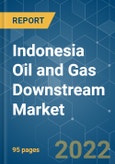The Indonesian oil and gas downstream market is expected to register a CAGR of more than 4% during the forecast period 2022-2027. The COVID-19 outbreak in Q1 2020 led to declines in the refining and petrochemical production output. Factors such as increasing demand for petrochemical products, growing oil and gas consumption, surging investments in the refinery, and petrochemical projects are expected to drive the oil and gas downstream market during the forecast period. However, an increase in the adoption of electric vehicles is expected to hinder the growth of the oil and gas downstream market.
The Indonesian oil and gas downstream market is moderately consolidated. The key players in the market include PT Pertamina (Persero), TotalEnergies SE, Chevron Corporation, Shell PLC, and Exxon Mobil Corporation, among others.
This product will be delivered within 2 business days.
- The refinery segment is expected to dominate the market during the forecast period, owing to increasing refining capacities across the country.
- Digitalization and modernization of the refining and petrochemical sectors are expected to reduce refining costs. This, in turn, is expected to create an opportunity for the market during the forecast period.
- Growing oil and gas consumption in the country is expected to be the major driver for the Indonesian oil and gas downstream market during the forecast period.
Key Market Trends
Refining Segment Expected to Dominate the Market
- The refineries segment generated significant demand for the Indonesian oil and gas downstream market in recent years and is expected to continue to do so during the forecast period too.
- Oil refining capacity in the country grew by over 2.5% in the last decade from 1,099 thousand barrels daily in 2010 to 1,127 thousand barrels daily in 2020. This is further expected to grow with the increasing consumption of oil products.
- The refinery throughput grew in recent years due to increasing domestic petroleum demand, rising petroleum prices, healthy growth in the tourism sector, and stable and high refinery margins.
- Indonesia is accelerating plans to almost double its oil refining capacity and reduce its dependence on fuel product imports. Pertamina, the state-backed oil company, announced plans to invest USD 48 billion over the next seven years to boost processing capacity to 1.8 million barrels per day from 1 million in 2020.
- In June 2020, the Balikpapan refinery located in East Kalimantan, Indonesia, was being expanded to increase its crude processing capacity by 40%, from 260,000 barrels per day (BPD) to 360,000 BPD. The refinery expansion project is being implemented in two phases, with phase one scheduled for completion in 2023 and phase two in 2026.
- Therefore, owing to the abovementioned reasons, the refinery segment is expected to dominate the Indonesian oil and gas downstream market during the forecast period.
Growing Oil and Gas Consumption to Drive the Market
- Indonesia is a developing country and has witnessed a significant increase in its oil and gas consumption in recent years, mainly due to growth in the industrial and commercial sectors and increasing population.
- Oil consumption in the country registered at around 1230 thousand barrels daily in 2020. Natural gas consumption in the country was more than 41.5 billion cubic meters in 2020.
- The rapid increase in demand for oil and gas is expected to continue during the forecast period and even beyond, fueled by a growing economy, industrial sector, and commercial sector.
- The increasing demand for oil and gas in the country has led to significant investments by major players in the country, like PT Pertamina (Persero), PT Perusahaan Gas Negara TBK, PT Connusa Energindo, and TotalEnergies SE. The share of major players in the country’s refining capacity is expected to grow during the forecast period.
- Hence, all the above factors are expected to help drive the Indonesian oil and gas downstream market during the forecast period.
Competitive Landscape
The Indonesian oil and gas downstream market is moderately consolidated. The key players in the market include PT Pertamina (Persero), TotalEnergies SE, Chevron Corporation, Shell PLC, and Exxon Mobil Corporation, among others.
Additional Benefits:
- The market estimate (ME) sheet in Excel format
- 3 months of analyst support
This product will be delivered within 2 business days.
Table of Contents
1 INTRODUCTION
4 MARKET OVERVIEW
5 MARKET SEGMENTATION - BY TYPE
6 COMPETITIVE LANDSCAPE
Companies Mentioned (Partial List)
A selection of companies mentioned in this report includes, but is not limited to:
- PT Pertamina (Persero)
- TotalEnergies SE
- Chevron Corporation
- Shell PLC
- Exxon Mobil Corporation
- PT Perusahaan Gas Negara TBK
- China National Petroleum Corporation
Methodology

LOADING...










